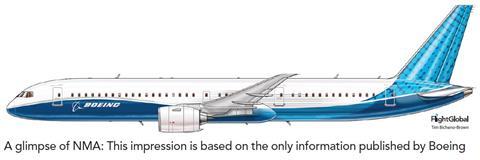Boeing’s head of marketing has downplayed the suitability of developing a modified 787 for the mid-market niche, comments following speculation Boeing could do just that.
“That’s a tough thing to do, and that’s why, at the end of the day, our customers put the [787-3] on hold, and they went to the [787-8],” Boeing vice-president of commercial aircraft marketing Randy Tinseth says on 12 February during the Singapore air show.
Boeing pitched the “787-3” to airline customers last decade before shelving that project in favour of the 787-8. In recent days, analyst Addison Schonland of AirInsight Group suggested the 787-3 could be an efficient and cost-effective mid-market solution for Boeing.
Recalling Boeing’s 787-3 experience, Tinseth says: “It was really, really, really, really hard to [de-rate]… a widebody like that – with that kind of cross section, with that kind of capability… to the point where you could really make it much more efficient than today’s single-aisle airplanes”.
“That’s a tough thing to do, and that’s why, at the end of the day, our customers put the -3 on hold, and they went to the [787-8],” Tinseth adds.
However, he stresses all options remain on the table for Boeing. “We are committed to investing,” Tinseth says.
Boeing had for years planned to tackle the mid-market space with a new 270-seat widebody dubbed the New Mid-market Airplane (NMA).
But the 737 Max crisis delayed that plan, and the NMA became more uncertain several weeks ago when chief executive David Calhoun said he had ordered a complete NMA rethink.

Boeing faces competition in the space from the Airbus A321XLR, which the European manufacturer launched at the Paris air show in 2019.
But, Boeing contends narrowbodies like Airbus’s offering lack sufficient comfort for mid-market flights, a segment the industry generally defines as including 4,000-5,000nm (7,400-9,260km) routes.
“I’m not sure about the concept,” Boeing vice-president of commercial sales and marketing Ihssane Mounir
says on 11 February. He adds that airlines would need to remove seats to make a narrowbody sufficiently comfortable for such flights.


























